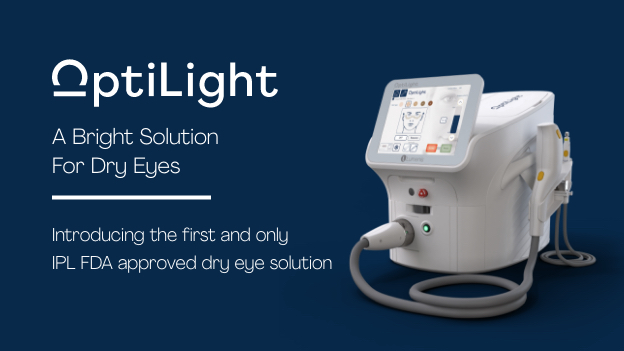Lumenis Receives FDA Approval for Its IPL Device to Manage Dry Eye Disease and Launches OptiLight™
April 29, 2021 – Yokne’am Illit, Israel.
Lumenis Ltd., the world’s largest energy-based medical device company for ophthalmic, aesthetic and surgical applications and the inventor of intense pulsed light (IPL) technology, today announced that the FDA has granted De Novo authorization for Lumenis’ newest IPL device for improving signs of dry eye disease due to meibomian gland dysfunction (MGD).
Dry eye disease is a common disorder that causes dry, gritty, burning, tired eyes and fluctuating vision. About 16 million Americans have been diagnosed,1 and twice as many may be undiagnosed with dry eye. MGD is the leading cause of dry eye disease, accounting for about 86% of cases.2
The Lumenis multi-center, double-blinded, randomized controlled FDA trial showed that Lumenis IPL with patented Optimal Pulse Technology (OPT®) significantly improved tear breakup time, meibum quality, and meibomian gland expressibility.3 The clinical trial joins a long list of studies of Lumenis’ IPL with OPT® that have shown the same results, as well as reduction of inflammatory markers.4-7
Subsequent to the FDA approval, Lumenis is launching OptiLight™, a bright solution for dry eyes. OptiLight™ with Lumenis’ patented OPT® technology is designed for a consistent, precise, and controlled light-based treatment of signs of dry eye disease.
“We deal with dry eye every day, but unless we address the underlying inflammation, it’s difficult to meaningfully impact the disease. OptiLight™ helps us to address the inflammation, as shown in Lumenis’ IPL clinical trials, and improves signs of dry eye disease due to MGD, positioning it as a valuable tool in our dry eye toolkit,” said Dr. Steven J. Dell, medical director of Dell Laser Consultants and lead investigator in the Lumenis’ clinical trial submitted to the FDA.
“Lumenis has launched many ‘firsts’ in eye care, and we never stop innovating. This is why we are excited that our IPL device with patented OPT® technology is the first and only such device to receive FDA approval for improving signs of dry eye disease. We’re exceptionally proud to elevate dry eye management and to improve the quality of life for millions of patients,” said Lumenis CEO Tzipi Ozer-Armon. “We are proud to launch OptiLight™️, a light-based system that provides doctors with a safe and effective dry eye procedure to add to their toolkit. We look forward to continued collaboration with doctors across the U.S. and globally in elevating dry eye care.”
Lumenis will unveil the new OptiLight™ at a formal virtual launch event on May 13, 2021, 7 p.m. EDT.
1. Farrand et al. Am J Ophthalmol 2017;182:90-98.
2. Lemp MA et al. (2012) Cornea May;31(5):472-8.
3. FDA study sponsored by Lumenis: internal reference LUM-VBU-M22-IPL-17-01.
4. Yan et al. (2020), Eye & Contact Lens 2021, 27(1):45-53.
5. Arita et al. (2019) Ocul Surf 17(1):308-13.
6. Gao et al. (2019) Int J Ophthalmol 12(11):1708-1713.
7. Liu et al. (2017) Am J Ophthalmol 183:81-90.
About Lumenis
www.lumenis.com
Lumenis is the world’s largest energy-based medical device company for surgical, aesthetic and ophthalmic applications in the area of minimally invasive clinical solutions. Regarded as a world-renowned expert in developing and commercializing innovative energy-based technologies, including Laser, Intense Pulsed Light (IPL) and Radio-Frequency (RF). For nearly 50 years, Lumenis’ ground-breaking products have redefined medical treatments and have set numerous technological and clinical gold standards. Lumenis has successfully created solutions for previously untreatable conditions, as well as designed advanced technologies that have revolutionized existing treatment methods.
About OptiLight
OptiLight™ is a new intense pulsed light (IPL) device, with a spectrum of 400-1200 nm, that is indicated for improvement of signs of Dry Eye Disease (DED) due to Meibomian Gland Dysfunction (MGD), also known as evaporative dry eye or lipid deficiency dry eye, in patients 22 years of age and older with moderate to severe signs and symptoms of DED due to MGD and with Fitzpatrick skin types I-IV. IPL is to be applied only to skin on the malar region of the face, from tragus to tragus including the nose (eyes should be fully covered by protective eyewear). IPL is intended to be applied as an adjunct to other modalities, such as meibomian gland expression, artificial tear lubricants and warm compresses.
Media Contact
Genevieve Britton
+1.512.774.0735 (c)
genevieve@pascalecommunications.com
Explore Other Resources
PB-00029590 Rev A
